Name Details:
Named By: James Cambron
Named For: Type Site
Date Identified: 1957
Type Site: Pine Tree site (Cambron site 76), Limestone County, Alabama
Pine Tree
Cluster:
Date:
Cultural Period:
9,500 -8,500 B.P.
Early Archaic
Early Holocene
Glacial Period:
Culture:
Outline is Representative of Size and Shape:
Description of Physical Characteristics and Flaking Pattern:
This is a
medium corner notched point with an elliptical, flattened, or median ridge cross section. The blade is most notable as an outward recurvate, but may be straight to
slightly incurvate and is serrated. The shoulders are horizontal to having a slightly upwards angle. The stem is expanding. The base may vary from convex to concave
and is thinned with light to heavy hafting region grinding being present. This point has a collateral to a random
flaking pattern.
Size Measurements: Total Length - 50 to 66 mm (59 mm average), Stem
Length -
11 to 15 mm (12 mm average), Blade Width - 25 to 29
mm (27 mm average), Stem Width - 26 to 29
mm (28 mm average), Thickness - 5 to 9 mm
Distribution:
Distribution Comments:
This point is found in the Tennessee River Valley and into the Ohio River valley and into the mid Mississippi River valley.

Additional Comments:
Justice (2002), states that this is a re-sharpened variant of the Kirk Corner Notch point. Cambron and Hulse (1969) describe this point as having the same hafting description as the Kirk Corner Notched, except
that the blade is narrower and may be thinner due to re-sharping. This variant however, retains the length of the blade during the re-sharping process.
There is a lot of confusion regarding this point and the Charleston point. Much of this confusion may
come from the similar appearance of these points and the overlapping distribution. Also, other identification guides have listed the two points as the same point with a northern
and southern distribution which is incorrect. The two points are not the same, the Charleston Corner Notched was found in levels below the Kirk Corner Notched point at St.
Albans site and Ice House Bottom site (Justice, 2002). This point is a re-sharpened Kirk variant. There are a few points that must be kept in mind regarding the two points. First is the distribution. Both point have a southern distribution, but the Charleston point is also found further east and the Pine Tree point is found further north.
Second, Broyle (1971), notes that the Charleston blade is generally shorter and wider. The blade is most commonly recurvate and
asymmetrical for the Charleston point (Justice, 2002). Also, the Charleston point more commonly has a median ridge which is less common with the Pine Tree. Third, the Pine Tree is a variant of a re-sharpened Kirk so the base is consistent with a Kirk Base. Like the Palmer point which also predates the Kirk, basal grinding is
more common for the Charleston and less common for the Pine Tree.
Other points in this Cluster:
Point Validity:
Cambron is a distinguished avocational archaeologist that did extensive work in Alabama and the Tennessee River valley. This point was named in a personally published book. This point has been referred to in numerous professional publications and is considered a valid type.
.
Age Details:
References: (See Reference Page, Entry Number):
12,
23, 30, 37, 179, 216, W11
Pine Tree Projectile Point, Pine Tree Arrowhead

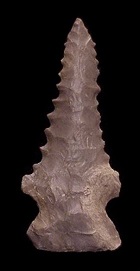
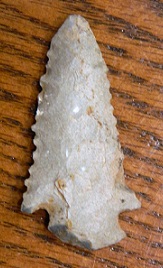
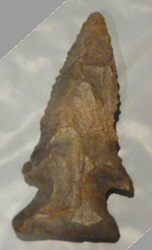
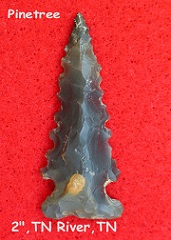
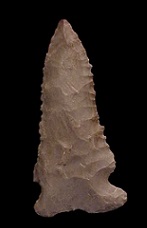
.jpg)